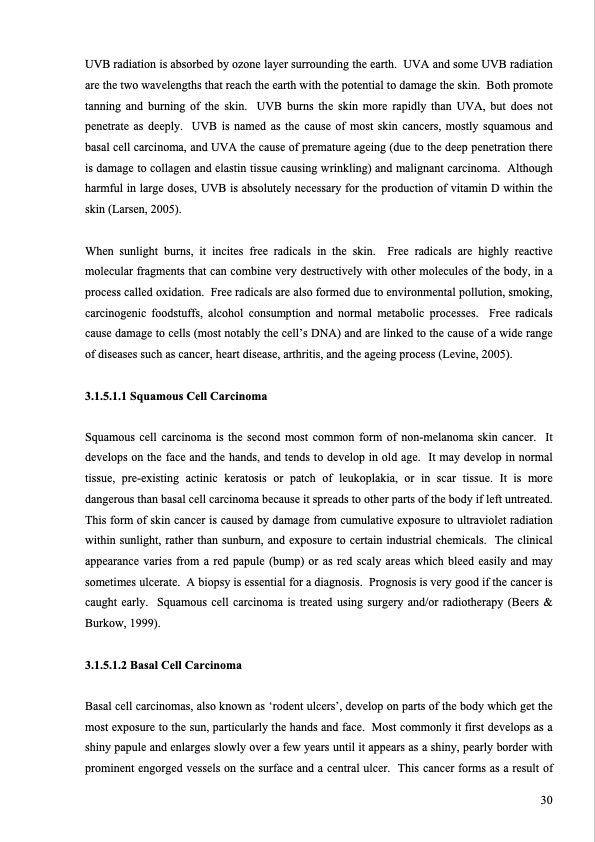
PDF Publication Title:
Text from PDF Page: 043
UVB radiation is absorbed by ozone layer surrounding the earth. UVA and some UVB radiation are the two wavelengths that reach the earth with the potential to damage the skin. Both promote tanning and burning of the skin. UVB burns the skin more rapidly than UVA, but does not penetrate as deeply. UVB is named as the cause of most skin cancers, mostly squamous and basal cell carcinoma, and UVA the cause of premature ageing (due to the deep penetration there is damage to collagen and elastin tissue causing wrinkling) and malignant carcinoma. Although harmful in large doses, UVB is absolutely necessary for the production of vitamin D within the skin (Larsen, 2005). When sunlight burns, it incites free radicals in the skin. Free radicals are highly reactive molecular fragments that can combine very destructively with other molecules of the body, in a process called oxidation. Free radicals are also formed due to environmental pollution, smoking, carcinogenic foodstuffs, alcohol consumption and normal metabolic processes. Free radicals cause damage to cells (most notably the cell’s DNA) and are linked to the cause of a wide range of diseases such as cancer, heart disease, arthritis, and the ageing process (Levine, 2005). 3.1.5.1.1 Squamous Cell Carcinoma Squamous cell carcinoma is the second most common form of non-melanoma skin cancer. It develops on the face and the hands, and tends to develop in old age. It may develop in normal tissue, pre-existing actinic keratosis or patch of leukoplakia, or in scar tissue. It is more dangerous than basal cell carcinoma because it spreads to other parts of the body if left untreated. This form of skin cancer is caused by damage from cumulative exposure to ultraviolet radiation within sunlight, rather than sunburn, and exposure to certain industrial chemicals. The clinical appearance varies from a red papule (bump) or as red scaly areas which bleed easily and may sometimes ulcerate. A biopsy is essential for a diagnosis. Prognosis is very good if the cancer is caught early. Squamous cell carcinoma is treated using surgery and/or radiotherapy (Beers & Burkow, 1999). 3.1.5.1.2 Basal Cell Carcinoma Basal cell carcinomas, also known as ‘rodent ulcers’, develop on parts of the body which get the most exposure to the sun, particularly the hands and face. Most commonly it first develops as a shiny papule and enlarges slowly over a few years until it appears as a shiny, pearly border with prominent engorged vessels on the surface and a central ulcer. This cancer forms as a result of 30PDF Image | THE USE OF LIGHT AND COLOUR AS A HEALING MODALITY

PDF Search Title:
THE USE OF LIGHT AND COLOUR AS A HEALING MODALITYOriginal File Name Searched:
light-healing-modality.pdfDIY PDF Search: Google It | Yahoo | Bing
Cruise Ship Reviews | Luxury Resort | Jet | Yacht | and Travel Tech More Info
Cruising Review Topics and Articles More Info
Software based on Filemaker for the travel industry More Info
The Burgenstock Resort: Reviews on CruisingReview website... More Info
Resort Reviews: World Class resorts... More Info
The Riffelalp Resort: Reviews on CruisingReview website... More Info
| CONTACT TEL: 608-238-6001 Email: greg@cruisingreview.com | RSS | AMP |